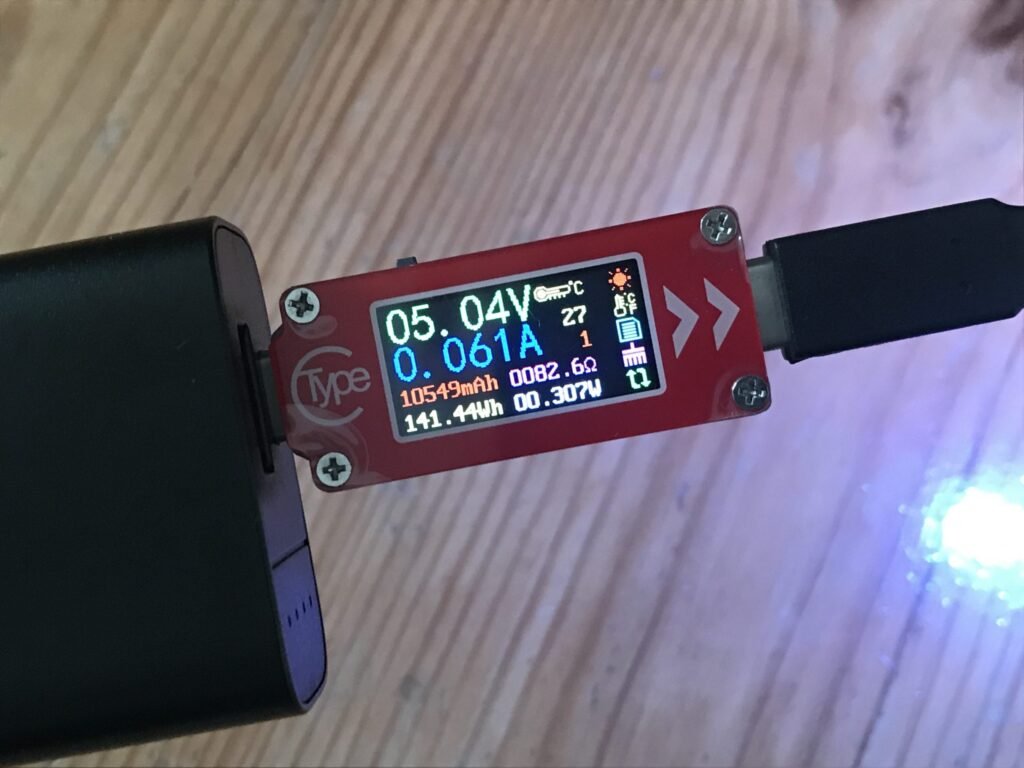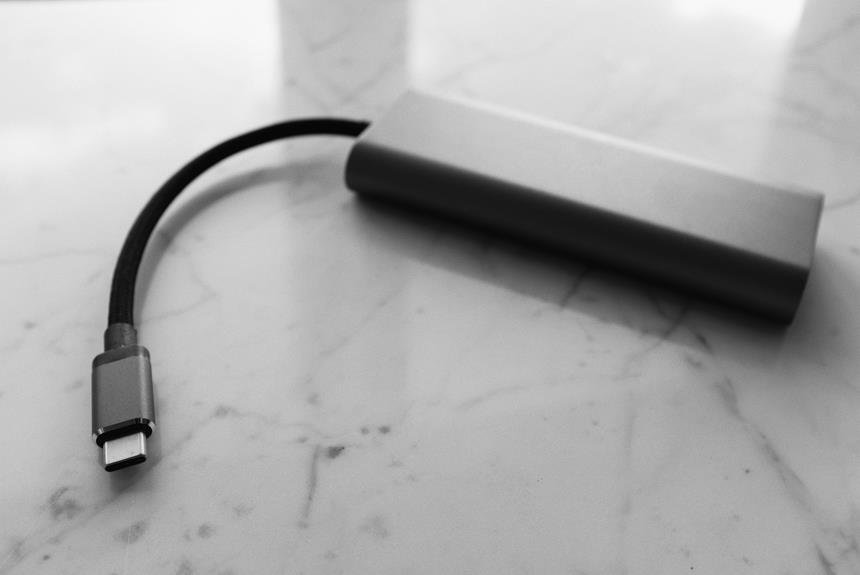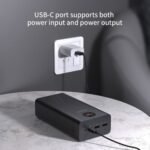Your power bank may automatically turn off due to several built-in safety features designed to protect both the power bank and connected devices. These include overcurrent protection, low power mode, and inactivity timers. Faulty connections or poor wiring can also cause shutdowns. Temperature management systems will trigger power cutoffs to prevent overheating. Additionally, mismatched voltage or current ratings with your device can lead to compatibility issues that force the power bank to turn off. Understanding these aspects can help you mitigate automatic shutdowns and optimize your power bank’s performance. Continue to explore these facets for a deeper insight into resolving this issue.

Built-in Safety Features
To secure user safety and prolong the lifespan of the device, power banks incorporate built-in safety features that automatically turn off the unit under certain conditions. You’ll find that these features are essential for maintaining peak performance and guaranteeing that your device remains dependable over time.
One key aspect of these safety features is circuit protection. Modern power bank designs are equipped with sophisticated circuitry that monitors various parameters such as temperature, voltage, and current. When abnormal conditions are detected, the power bank will automatically shut down to prevent damage. This is particularly important when considering charging speed and port compatibility. With multiple devices often charging simultaneously, the potential for overheating or overloading is significant. Circuit protection mitigates these risks, allowing you to charge your devices quickly and safely.
Furthermore, the design of the power bank plays an important role in its overall safety. Quality power banks are engineered with robust materials and advanced technologies that enhance durability and reliability. By integrating features like short-circuit protection and thermal regulation, these devices ensure safe and efficient operation. So, when you’re selecting a power bank, prioritize those with inclusive built-in safety features to enjoy both freedom and peace of mind.
Overcurrent Protection
Overcurrent protection is a critical feature that prevents excessive current flow, safeguarding both the power bank and your connected devices. When the current flowing through your power bank exceeds the safe threshold, the overcurrent protection mechanism kicks in, automatically shutting down the device. This not only safeguards the longevity of your power bank but also protects your valuable gadgets from potential damage.
A short circuit is another scenario where overcurrent protection proves invaluable. If a short circuit occurs, the current can surge to dangerously high levels. Without overcurrent protection, this could result in overheating, component damage, or even fire hazards. By cutting off the power supply instantly, overcurrent protection mitigates these risks, keeping you and your devices safe.
Additionally, overcurrent protection works in tandem with voltage regulation to maintain a stable output. Voltage regulation ensures that the power bank supplies a consistent voltage level to your devices, while overcurrent protection ensures that the current remains within safe limits. Together, these features provide a balanced and secure charging environment, allowing you to use your power bank with confidence and peace of mind. This combination of protections offers you the freedom to charge your devices without concern.
Low Power Mode
Low energy mode conserves battery life by reducing the power bank’s energy output and limiting non-essential functions. When you activate low energy mode, the power bank intelligently manages its energy distribution to make sure that only the most important tasks are prioritized. This functionality directly addresses battery drainage, prolonging the operational lifespan of your device.
By using power saving modes, the power bank minimizes energy consumption, allowing you to maximize the available charge. These modes often disable non-critical features, such as LED indicators or unnecessary data transmissions, focusing the energy on charging your essential devices. This is particularly helpful when you’re on the move and need to extend your power bank’s usability over a longer period.
You’ll find that low energy mode is not just a feature but a necessity in modern power banks. It provides an additional layer of control, enabling you to decide when and how to conserve energy according to your needs. Essentially, it’s about giving you the freedom to use your devices longer without the constant worry of battery drainage, making sure that you remain connected and powered up when it matters most.
Inactivity Timer
The inactivity timer in a power bank automatically powers down the device after a specified period of inactivity, conserving energy and preventing unnecessary battery drain. This timer function is essential for maximizing power consumption, guaranteeing that the power bank remains energy efficient. When you’re not actively using your power bank, the inactivity timer kicks in, switching the device to standby mode. This minimizes energy wastage, extending the overall life of the power bank.
For those who value freedom and efficiency, the inactivity timer is a feature that liberates you from constantly monitoring your device. Imagine you’re on a long trek, and you don’t want to worry about your power bank draining itself when not in use. The timer function ensures that your power bank only consumes power when necessary, enhancing its energy efficiency and reliability.
Moreover, this feature is especially beneficial when you’re charging multiple devices. The power bank will automatically switch off if it detects no active charging, guaranteeing that it doesn’t continue to drain its own battery. This makes the inactivity timer an indispensable tool for maintaining peak power consumption and prolonging the utility of your device.
Faulty Connections
While the inactivity timer boosts energy efficiency, faulty connections can undermine the performance and reliability of your power bank. Loose connections and power fluctuations are often culprits behind automatic shutdowns. When the internal wiring is compromised, the power bank can’t maintain a stable flow of electricity. Consequently, the device’s safety mechanisms trigger a shutdown to prevent potential damage or hazards.
Charging port issues are another common problem. Over time, frequent use can lead to wear and tear, resulting in a loose connection between the charging cable and the port. This instability causes intermittent power transfer, prompting the power bank to turn off unexpectedly. Faulty wiring within the device can exacerbate these issues, leading to inconsistent power delivery and frequent interruptions.
A detailed inspection is essential to identify and rectify these problems. Check for visible signs of damage or wear in the charging port, and verify all connections are secure. If you suspect faulty wiring, professional repair may be necessary to restore reliable functionality. By addressing these technical issues, you can make sure your power bank operates efficiently and meets your mobile power needs without unexpected interruptions.
Battery Health
Your power bank’s overall performance and longevity heavily depend on the health of its battery cells. Proper battery maintenance is key to making sure that your device remains reliable and efficient. If the battery cells are compromised, your power bank might automatically shut down to protect itself and the devices it charges.
To maintain the health of your power bank’s battery, consider your charging habits. Overcharging or undercharging can degrade battery performance significantly. Aim to keep the battery level between 20% and 80% for best longevity. Also, avoid using the power bank while it’s charging, as this can generate excess heat and stress the battery.
Here’s a quick comparison to help you understand the impact of different charging habits:
| Charging Habit | Impact on Battery Health |
|---|---|
| Overcharging | Reduces overall lifespan |
| Undercharging | Can cause battery stress |
| Balanced Charging (20%-80%) | Maintains longevity |
Another aspect of battery maintenance is using the correct charger. Mismatched chargers can lead to inefficient charging cycles, further stressing the battery cells. Always use the recommended charger for your power bank to ensure safe and effective charging.
Temperature Control
Maintaining ideal temperature is equally important as proper battery health to prevent your power bank from automatically shutting off. Effective thermal management is essential for ensuring stable operation and longevity of your device. When your power bank overheats, its internal circuitry is designed to cut off power consumption to protect both the battery and the connected devices. This safety feature is crucial but can be inconvenient if you’re relying on it for power on-the-go.
Heat dissipation plays a significant role in maintaining best operating temperatures. Most high-quality power banks incorporate advanced materials and design features to enhance heat dissipation. These mechanisms ensure that the device doesn’t retain excessive heat, allowing it to maintain a faster charging speed without compromising safety.
You should also be aware that environmental factors, such as ambient temperature, can impact your power bank’s thermal management. Operating your device in extreme temperatures, whether too hot or too cold, can trigger the automatic shutdown feature. By understanding and managing these variables, you can optimize your power bank’s performance and minimize disruptions. Adopting these practices will guarantee reliable power delivery, granting you the freedom to stay connected without unexpected interruptions.
Power Bank Capacity
When considering power bank capacity, you should evaluate battery energy density, which directly affects how much charge the device can store. Additionally, charge cycle limits are essential as they determine the longevity and efficiency of the power bank over time. Understanding these factors helps you choose a power bank that meets your energy needs while ensuring durability.
Battery Energy Density
The battery energy density of a power bank, often measured in watt-hours per kilogram (Wh/kg), directly impacts its capacity to store and deliver electrical energy efficiently. Higher energy density means your power bank can store more power in a smaller, lighter package, enhancing its portability and convenience. Advanced battery technology plays a pivotal role here, as it influences both the charging speed and overall battery life of your portable chargers.
When choosing a power bank, a higher energy density can guarantee that your devices charge faster and last longer. This is particularly significant if you value freedom and mobility, as you don’t want to be tethered to a wall socket frequently. Modern lithium-polymer and lithium-ion batteries are popular choices due to their superior energy densities, allowing for compact, powerful portable chargers.
However, the quest for higher energy density must balance with safety and durability. As the energy density increases, so does the potential for overheating or other failures if not managed properly. As a result, understanding the interplay between energy density and reliability is crucial for choosing a power bank that meets your needs without compromising safety. High-quality battery technology ensures that you get the most out of each charge, maintaining efficiency and longevity.
Charge Cycle Limits
Understanding battery energy capacity is only part of the equation; you also need to consider a power bank’s charge cycle limits to evaluate its long-term capacity. Each power bank has a finite number of charge cycles, which directly impacts battery longevity. A charge cycle refers to the process of using up all the power in the power bank and then recharging it to full capacity. Over time, the number of charge cycles will decrease, reducing the power bank’s overall lifespan.
Your charging habits greatly influence these charge cycles. For example, frequently topping off your power bank instead of letting it discharge fully can lead to more rapid wear. Similarly, heavy usage patterns can accelerate the degradation process, shortening the lifespan of your power bank.
Here’s a quick look at how different factors affect power bank longevity:
| Factor | Impact on Longevity |
|---|---|
| Full Discharge Cycles | Higher longevity |
| Partial Charges | Reduced longevity |
| Heavy Usage Patterns | Accelerated degradation |
| Moderate Usage | Balanced lifespan |
| Proper Storage | Maintains battery health |
Therefore, understanding and adapting your usage patterns and charging habits can significantly prolong the life of your power bank. By being mindful of these factors, you can ensure your power bank remains a reliable companion for all your adventures.
Device Compatibility
Ensuring your power bank is compatible with various devices involves checking voltage, current ratings, and connector types. Mismatched specifications can lead to automatic shutoffs, impacting charging speed and efficiency. First, verify your power bank’s output voltage aligns with your device’s requirements. Most smartphones use 5V, while some tablets and laptops may need higher voltages. Incompatibility here triggers safety mechanisms, cutting off power.
Next, examine current ratings. If your power bank’s current is too low, it struggles to charge your device, leading to frequent disconnections. Conversely, excessive current can cause overheating, prompting the power bank to shut down as a precaution. Check both your power bank’s maximum output current and your device’s ideal charging current.
Connector types are also critical. USB-C, Micro-USB, and Lightning connectors each have distinct specifications. Using an incompatible connector can either fail to charge your device or cause intermittent connections that trigger automatic shutoffs.
Lastly, consider device settings. Some devices have specific power management settings that may not align with your power bank’s capabilities. Adjusting these settings can mitigate compatibility issues, ensuring a seamless charging experience. Therefore, ensuring compatibility enhances both functionality and freedom from constant recharging interruptions.
Frequently Asked Questions
How Can I Reset My Power Bank?
To reset your power bank, follow these power bank troubleshooting steps: press the reset button, or hold the power button for 10 seconds. Regular power bank maintenance guarantees peak performance and prevents automatic shutdowns.
Why Does My Power Bank Not Charge Certain Devices?
Your power bank might not charge certain devices due to compatibility issues or charging limitations. Some power banks are designed for specific voltage and current outputs, which may not match your device’s requirements, causing charging failure.
Can I Use My Power Bank While It’s Charging?
Imagine balancing on a tightrope: using your power bank while it’s charging risks charging safety. It’s a multitasking marvel, but beware of overloading, which can shorten battery lifespan. Your freedom demands careful consideration of these factors.
Do Power Banks Have an Expiration Date?
Yes, power banks have a lifespan. The impact of age and usage cycles affects their efficiency. Typically, a power bank lifespan is around 300-500 charge cycles, after which capacity diminishes, limiting your freedom to charge devices effectively.
How Do I Know if My Power Bank Is Fully Charged?
Picture the LED lights on your power bank. When all charging indicators are lit, your power bank’s battery capacity is full. Most devices have these indicators to show charging progress, ensuring you’re always ready to go.



